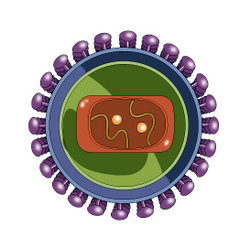Microbiology
|
|
Microbiology (in Greek micron = small and biologia = studying life) is the study of microorganisms, including viruses, prokaryotes and simple eukaryotes. Today, most of the work in microbiology is done using methods from biochemistry and genetics. It is also related to pathology, immunology, and epidemiology as many microorganisms are pathogens.
Microbiologists have made many fundamental contributions to biology and medicine, especially in the fields of biochemistry, genetics, and cell biology. Microbes have many traits that make them ideal model organisms:
- They are small, therefore they do not consume many resources
- Some have very short generation times (the time needed for division of a bacterial cell in two in optimal conditions; ~30 minutes for E. coli, but 12 to 24 hours for Mycobacterium tuberculosis)
- Cells can easily survive in isolation from other cells
- Unicellular eukaryotes reproduce by mitotic division and prokaryotes by binary fission. This allows for the propagation of genetically identical (clonal) populations.
- They may be frozen for long periods of time. Even if 90% of the cells are killed by the freezing process, there are millions of cells in a milliliter of liquid culture.
These traits allowed Joshua and Esther Lederberg to devise an elegant experiment in 1951 demonstrating that adaptive mutations arise from preadaptation rather than directed mutation. For this purpose, they invented replica plating, which allowed them to transfer numerous bacterial colonies from their specific locations on one agar-filled petri dish to analogous locations on several other petri dishes. After replicating a plate of E. coli, they exposed each of the new plates to a bacteriophage (also called phage). They observed that phage-resistant colonies were present at analogous locations on each of the plates, allowing them to conclude that the phage resistance trait had existed in the original colony, which had never been exposed to phage, instead of arising after the bacteria had been exposed to the virus.
The extensive characterization of microbes has allowed them to be used in industry and as experimental tools in different branches of biology:
- Bacteria and simple eukaryotes contain small circular DNAs, called plasmids. Plasmids can be genetically modified in vitro then inserted into bacteria that are grown in a culture to produce large amounts of protein using genes encoded on a plasmid. The proteins produced vary widely, some of them are for example antibiotics.
- Many microbes exploit energy by the process of anaerobic fermentation, in which different simple organic molecules are produced. This gave rise to the science of industrial fermentation. In this way it is possible to produce different antibiotics, beer, vinegar and other substances.
- Bacterial genes have been inserted into other organisms as reporter genes.
- The yeast two-hybrid system combines bacterial genes with genes from the organism being studied and inserts them into yeast cells to study protein-protein interactions within a cellular environment.
See also
- Archaea
- Bacterium
- Biochemistry
- Eukaryote
- Genetics
- Geomicrobiology
- Immunology
- Medicine
- Prokaryote
- Virology
- Return to Biology, Category:Biology
External links
- Online Microbiology textbook (http://www.bact.wisc.edu/Microtextbook)
- GIDEON Microbiology tutorial (http://www.GIDEONonline.com/tutorial/microbiology.htm) - Using GIDEON's Microbiology module
- Text Book of Bacteriology (http://www.textbookofbacteriology.net/)
- Deep Hot Biosphere (Thomas Gold) (http://people.cornell.edu/pages/tg21/DHB.html)
| General subfields within biology |
|---|
| Anatomy | Astrobiology | Biochemistry | Bioinformatics | Botany | Cell biology | Ecology | Developmental biology | Evolutionary biology | Genetics | Genomics | Marine biology | Human biology | Microbiology | Molecular biology | Origin of life | Paleontology | Parasitology | Physiology | Taxonomy | Zoology |

